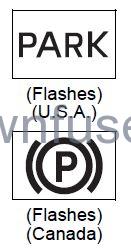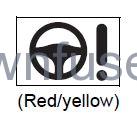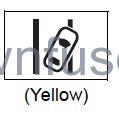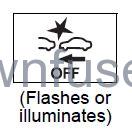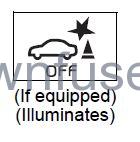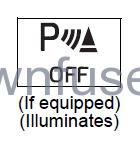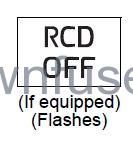2022 Toyota Camry Steps to Take in an Emergency

Steps to Take in an Emergency
If your vehicle needs to be towed
- If towing is necessary, we recommend having your vehicle towed by your Toyota dealer or commercial towing service, using a wheel-lift type truck or flatbed truck.
- Use a safety chain system for all towing, and abide by all state/provincial and local laws.
2WD models: If towing your vehicle with a wheel-lift type truck from the front, the vehicle’s rear wheels and axles must be in good condition. (P. 521, 523) - If they are damaged, use a towing dolly or flatbed truck.
- AWD models: If towing your vehicle with a wheel-lift type truck, use a towing dolly. (P. 521, 523)
WARNING
Observe the following precautions. Failure to do so may result in death or serious injury.
When towing the vehicle
- 2WD models
- Be sure to transport the vehicle with the front wheels raised or with all four wheels raised off the ground. If the vehicle is towed with the front wheels contacting the ground, the drivetrain and related parts may be damaged.
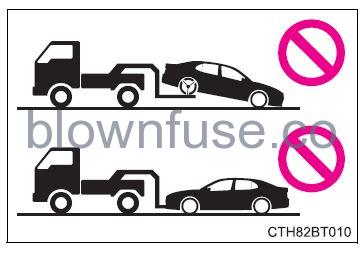
- Be sure to transport the vehicle with the front wheels raised or with all four wheels raised off the ground. If the vehicle is towed with the front wheels contacting the ground, the drivetrain and related parts may be damaged.
- AWD models
- Be sure to transport the vehicle with all four wheels raised off the ground. If the vehicle is towed with the tires contacting the ground, the drivetrain or related parts may be damaged, the vehicle may fly off the truck.
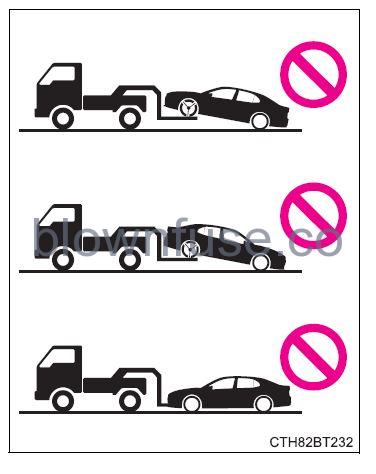
- Be sure to transport the vehicle with all four wheels raised off the ground. If the vehicle is towed with the tires contacting the ground, the drivetrain or related parts may be damaged, the vehicle may fly off the truck.
While towing
- When towing using cables or chains, avoid sudden starts, etc. which place excessive stress on the towing eyelets, cables, or chains. The towing eyelets, cables, or chains may become damaged, broken debris may hit people, and cause serious damage.
- Vehicles without a smart key system: Do not turn the engine switch to the “LOCK” position. There is a possibility that the steering wheel is locked and cannot be operated.
- Vehicles with a smart key system: Do not turn the engine switch off. There is a possibility that the steering wheel is locked and cannot be operated
NOTICE
- To prevent damage to the vehicle when towing using a wheel-lift type truck
- Vehicles without a smart key system: Do not tow the vehicle from the rear when the engine switch is in the “LOCK” position or the key is removed. The steering lock mechanism is not strong enough to hold the front wheels straight.
- Vehicles with a smart key system: Do not tow the vehicle from the rear when the engine switch is off. The steering lock mechanism is not strong enough to hold the front wheels straight.
- When raising the vehicle, ensure adequate ground clearance for towing at the opposite end of the raised vehicle. Without adequate clearance, the vehicle could be damaged while being towed.
- To prevent damage to the vehicle when towing with a sling-type truck Do not tow with a sling-type truck, either from the front or rear.
- To prevent damage to the vehicle during emergency towing
- Do not secure cables or chains to the suspension components.
- Recreational towing (behind the motor home, etc.) P. 208
Situations when it is necessary to contact dealers before towing
The following may indicate a problem with your transmission. Contact your Toyota dealer or commercial towing service before towing.
- The engine is running but the vehicle does not move.
- The vehicle makes an abnormal sound.
Towing with a wheel-lift type truck
- From the front (2WD models)
- From the front (AWD models)

- Release the parking brake.
- Vehicles with electric parking brake: Turn automatic mode off. P. 225)
- Use a towing dolly under the rear wheels.
- From the rear
- Use a towing dolly under the front wheels.
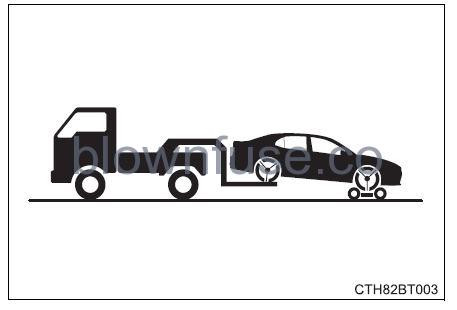
- Use a towing dolly under the front wheels.
Towing with a sling-type truck
Do not tow with a sling-type truck to prevent body damage.
2WD models
AWD models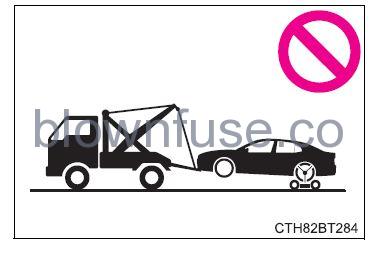
Using a flatbed truck.
When using a flat-bed truck to transport the vehicle, use tire strapping belts. Refer to the owner’s manual of the flat-bed truck for the tire strapping method.
- Vehicles without a smart key system
- In order to suppress vehicle movement during transportation, set the parking brake and turn the engine switch to the “LOCK” position.
- Vehicles with a smart key system
- In order to suppress vehicle movement during transportation, set the parking brake and turn the engine switch off.
Emergency towing
A driver must be in the vehicle to steer and operate the brakes. The vehicle’s wheels, drive train, axles, steering and brakes must be in good condition.
If you think something is wrong
If you notice any of the following symptoms, your vehicle probably needs adjustment or repair. Contact your Toyota dealer as soon as possible.
Visible symptoms
- Fluid leaks under the vehicle. (Water dripping from the air conditioning after use is normal.)
- Flat-looking tires or uneven tire wear
- Engine coolant temperature gauge needle continually points higher than normal
Audible symptoms
- Changes in exhaust sound
- Excessive tire squeal when cornering
- Strange noises related to the suspension system
- A pinging or other noises related to the engine
Operational symptoms
- Engine missing, stumbling, or running roughly
- Appreciable loss of power
- The vehicle pulls heavily to one side when braking
- Vehicle pulls heavily to one side when driving on a level road
- Loss of brake effectiveness, spongy feeling, pedal almost touches the floor
Fuel pump shut off system
To minimize the risk of fuel leakage when the engine stalls or when an airbag inflates upon collision, the fuel pump shut-off system stops the supply of fuel to the engine.
Follow the procedure below to restart the engine after the system is activated.
- Vehicles without a smart key system
- Turn the engine switch to the “ACC” or “LOCK” position.
- Restart the engine.
- Vehicles with a smart key system
- Turn the engine switch off.
- Restart the engine.
NOTICE
Before starting the engine Inspect the ground under the vehicle. If you find that fuel has leaked onto the ground, the fuel system has been damaged and is in need of repair. Do not restart the engine.
If a warning light turns on or a warning buzzer sounds
Calmly perform the following actions if any of the warning lights comes on or flash. If a light comes on or flashes, but then goes off, this does not necessarily indicate a malfunction in the system. However, if this continues to occur, have the vehicle inspected by your Toyota dealer.
Warning light and warning buzzer list
| Warning light | Warning light/Details/Actions |
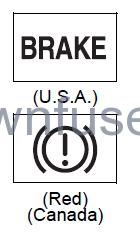
(the U.S.A.) (Red) (Canada) |
Brake system warning light
Indicates that: • The brake fluid level is low; or • The brake system is malfunctioning ® Immediately stop the vehicle in a safe place and contact your Toyota dealer. Continuing to drive the vehicle may be dangerous. |
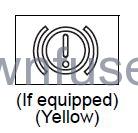
(If equipped) (Yellow) |
Brake system warning light
Indicates a malfunction in the electric parking brake ® Have the vehicle inspected by your Toyota dealer immediately. |
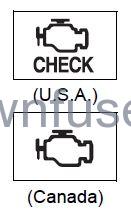
(the U.S.A.) (Canada) |
Malfunction indicator lamp
Indicates a malfunction in: • The electronic engine control system; • The electronic throttle control system; or • The electronic automatic transmission control system ® Have the vehicle inspected by your Toyota dealer immediately. |
|
|
SRS warning light
Indicates a malfunction in: • The SRS airbag system; • The front passenger occupant classification system; or • The seat belt pre-tensioner system ® Have the vehicle inspected by your Toyota dealer immediately. |

(U.S.A.) (Canada) |
ABS warning light
Indicates a malfunction in: • The ABS; or • The brake assist system ® Have the vehicle inspected by your Toyota dealer immediately. |
| Warning light | Warning light/Details/Actions |
 |
Inappropriate pedal operation warning light (warning buzzer)*1
When a buzzer sounds: Indicates a malfunction in: • The Brake Override System • The Drive-Start Control • Parking Support Brake (if equipped) ® Have the vehicle inspected by your Toyota dealer immediately. • Indicates that the shift position was changed and Drive- Start Control was operated while depressing the accelerator pedal. ® Momentarily release the accelerator pedal. When a buzzer does not sound: Indicates that the accelerator and brake pedals are being depressed simultaneously, and the Brake Override System is operating. ® Release the accelerator pedal and depress the brake pedal. |
|
|
Parking brake indicator (warning buzzer)*2
It is possible that the parking brake is not fully engaged or released ® Operate the parking brake once again. This light comes on when the parking brake is not released. If the light turns off after the parking brake is fully released, the system is operating normally. |
|
|
Brake hold operated indicator
Indicates a malfunction in the brake hold system ® Have the vehicle inspected by your Toyota dealer immediately. |
|
(Red/Yellow) |
Electric power steering system warning light (warning buzzer)
Indicates a malfunction in the EPS (Electric Power Steering) system ® Have the vehicle inspected by your Toyota dealer immediately. |
|
(Yellow) |
LTA indicator (warning buzzer)*1
Indicates a malfunction in the LTA (Lane Tracing Assist) ® Follow the instructions displayed on the multi-information display. (®P. 284) |
| Warning light | Warning light/Details/Actions |
|
|
PCS warning light
When a buzzer sounds simultaneous: Indicates a malfunction has occurred in the PCS (Pre-Col- lision System). ® Have the vehicle inspected by your Toyota dealer immediately. When a buzzer does not sound: The PCS (Pre-Collision System) has become temporarily unavailable, corrective action may be necessary. ® Follow the instructions displayed on the multi-information display. (®P. 252, 538) If the PCS (Pre-Collision System) or VSC (Vehicle Stability Control) system is disabled, the PCS warning light will illuminate. ® P. 269 |
|
|
PKSB OFF indicator
When a buzzer sounds: Indicates a malfunction in the Parking Support Brake system ® Have the vehicle inspected by your Toyota dealer immediately. When a buzzer does not sound: Indicates that the system is temporarily unavailable, possibly due to a sensor being dirty or covered with ice, etc. ® Clear the dirt, etc. |
|
|
Intuitive parking assist OFF indicator*1
Indicates a malfunction in the intuitive parking assist function ® Have the vehicle inspected by your Toyota dealer immediately. Indicates that the system is temporarily unavailable, possibly due to a sensor being dirty or covered with ice, etc. ® Clear the dirt, etc. |
|
|
RCD OFF indicator*1
When a buzzer sounds: Indicates a malfunction in the RCD (Rear Camera Detection) function ® Have the vehicle inspected by your Toyota dealer immediately. When a buzzer does not sound: Indicates that the function temporarily cannot be used due to the camera being dirty, etc. ® Clear the dirt, etc. |
| Warning light | Warning light/Details/Actions |
 |
Slip indicator
Indicates a malfunction in: • The VSC (Vehicle Stability Control) system; • The TRAC (Traction Control) system; or • The ABS The light will flash when the VSC or the TRAC system is operating. ® Have the vehicle inspected by your Toyota dealer immediately. |
 |
Low fuel level warning light
u For 2WD models Indicates that the remaining fuel is approximately 2.4 gal. (9.1 L, 2.0 Imp. gal.) u For AWD models Indicates that the remaining fuel is approximately 2.2 gal. (8.2 L, 1.8 Imp. gal.) ® Refuel the vehicle. |
 |
Driver’s and front passenger’s seat belt reminder light (warning buzzer)*3
Warns the driver and/or front passenger to fasten their seat belts ® Fasten the seat belt. If the front passenger’s seat is occupied, the front passenger’s seat belt also needs to be fastened to make the warning light (warning buzzer) turn off. |
 |
Rear passengers’ seat belt reminder lights (warning buzzer)*4
Warns the rear passengers to fasten their seat belts. ® Fasten the seat belt. |
 |
Master warning light
A buzzer sounds and the warning light comes on and flashes to indicate that the master warning system has detected a malfunction. ® P. 538 |
 |
Tire pressure warning light
Indicates the following: • Low tire pressure due to flat tire; • Low tire pressure due to natural causes; or • The tire pressure warning system is malfunctioning ® Immediately stop the vehicle in a safe place. Handling method (®P. 534) |
- This light illuminates the multi-information display.
- Parking brake engaged warning buzzer:
- A buzzer will sound if the vehicle is driven at a speed of approximately 3 mph (5 km/h) or more.
- Driver’s seat belt warning buzzer:
- Vehicles without a smart key system: The driver’s seat belt warning buzzer sounds to alert the driver that his or her seat belt is not fastened. Once the engine switch is turned to the “ON” position, the buzzer sounds. If the seat belt is still unfastened, the buzzer sounds intermittently for a certain period of time after the vehicle reaches a certain speed.
- Vehicles with a smart key system: The driver’s seat belt warning buzzer sounds to alert the driver that his or her seat belt is not fastened. Once the engine switch is turned to IGNITION ON mode, the buzzer sounds. If the seat belt is still unfastened, the buzzer sounds intermittently for a certain period of time after the vehicle reaches a certain speed.
- Front passenger’s seat belt warning buzzer: The front passenger’s seat belt warning buzzer sounds to alert the front passenger that his or her seat belt is not fastened. If the seat belt is unfastened, the buzzer sounds intermittently for a certain period of time after the vehicle reaches a certain speed.
- Rear passengers’ seat belt warning buzzer:
- The rear passenger’s seat belt warning buzzer sounds to alert the rear passenger that his or her seat belt is not fastened. If the seat belt is unfastened, the buzzer sounds intermittently for a certain period of time, after the seat belt is fastened and unfastened and the vehicle reaches a certain speed.
SRS warning light
This warning light system monitors the airbag sensor assembly, front impact sensors, side-impact sensors (front door), side-impact sensors (front), side-impact sensors (rear), driver’s seat position sensor, driver’s seat belt buckle switch, front passenger occupant classification system (ECU and sensors), “AIRBAG ON” indicator light, “AIRBAG OFF” indicator light, seat belt pretense-tensioners, airbags, interconnecting wiring, and power sources. (P. 38)
Front passenger detection sensor, seat belt reminder, and warning buzzer
- If the luggage is placed on the front passenger seat, the front passenger detection sensor may cause the warning light to flash and the warning buzzer to sound even if a passenger is not sitting in the seat.
- If a cushion is placed on the seat, the sensor may not detect a passenger, and the warning light may not operate properly.
If the malfunctioning indicator lamp comes on while driving
- First, check the following:
- Is the fuel tank empty?
- If it is, fill the fuel tank immediately.
- Is the fuel tank cap loose?
- If it is, tighten it securely.
- The light will go off after several driving trips.
- If the light does not go off even after several trips, contact your Toyota dealer as soon as possible.
Electric power steering system warning light (warning buzzer)
When the battery charge becomes insufficient or the voltage temporarily drops, the electric power steering system warning light may come on and the warning buzzer may sound.
When the tire pressure warning light comes on
Inspect the tires to check if a tire is punctured.
- If a tire is punctured: P. 543
- If none of the tires are punctured:
Turn the engine switch off then turn it to the “ON” position (vehicle without a smart key system) or IGNITION ON mode (vehicle with a smart key system). Check if the tire pressure warning light comes on or blinks. - If the tire pressure warning light comes on
- After the temperature of the tires has lowered sufficiently, check the inflation pressure of each tire and adjust them to the specified level. If the warning light does not turn off even after several minutes have elapsed, check that the inflation pressure of each tire is at the specified level and perform initialization. (P. 475)
- If the warning light does not turn off several minutes after the initialization has been performed, have the vehicle inspected by your Toyota dealer immediately.
- If the tire pressure warning light blinks for 1 minute then stays on There may be a malfunction in the tire pressure warning system. Has the vehicle been inspected by your Toyota dealer immediately?
- The tire pressure warning light may come on due to natural causes The tire pressure warning light may come on due to natural causes such as natural air leaks and tire inflation pressure changes caused by temperature. In this case, adjusting the tire inflation pressure will turn off the warning light (after a few minutes).
- When a tire is replaced with a spare tire
The compact spare tire is not equipped with a tire pressure warning valve and transmitter. If a tire goes flat, the tire pressure warning light will not turn off even though the flat tire has been replaced with a spare tire. Replace the spare tire with the repaired tire and adjust the tire inflation pressure. The tire pressure warning light will go off after a few minutes. - Conditions that the tire pressure warning system may not function properly P. 480
- Warning buzzer
- In some cases, the buzzer may not be heard because of a noisy place or an audio sound.
WARNING
- If both the ABS and the brake system warning lights remain on Stop your vehicle in a safe place immediately and contact your Toyota dealer. The vehicle will become extremely unstable during braking, and the ABS system may fail, which could cause an accident resulting in death or serious injury.
- When the electric power steering system warning light comes on When the light comes on yellow, the assistance to the power steering is restricted. When the light comes on red, the assist to the power steering is lost and handling operations of the steering wheel become extremely heavy. When steering wheel operations are heavier than usual, grip the steering wheel firmly and operate it using more force than usual.
- If the tire pressure warning light comes on
Be sure to observe the following precautions. Failure to do so could cause a loss of vehicle control and result in death or serious injury.- Stop your vehicle in a safe place as soon as possible. Adjust the tire inflation pressure immediately.
- If the tire pressure warning light comes on even after tire inflation pres-sure adjustment, it is probable that you have a flat tire. Check the tires. If a tire is flat, change it with the spare tire and have the flat tire repaired by the nearest Toyota dealer.
- Avoid abrupt maneuvering and braking. If the vehicle tires deteriorate, you could lose control of the steering wheel or the brakes.
- If a blowout or sudden air leakage should occur
- The tire pressure warning system may not activate immediately.
Maintenance of the tires
- Each tire, including the spare (if provided), should be checked monthly when cold and inflated to the inflation pressure recommended by the vehicle manufacturer on the vehicle placard or tire inflation pressure label (tire and load information label). (If your vehicle has tires of a different size than the size indicated on the vehicle placard or tire inflation pressure label [tire and load information label], you should determine the proper tire inflation pressure for those tires.)
- As an added safety feature, your vehicle has been equipped with a tire pressure monitoring system (TPMS-tire pressure warning system) that illuminates a low tire pressure telltale (tire pressure warning light) when one or more of your tires is significantly under-inflated. Accordingly, when the low tire pressure telltale (tire pressure warning light) illuminates, you should stop and check your tires as soon as possible, and inflate them to the proper pressure. Driving on a significantly under-inflated tire causes the tire to overheat and can lead to tire failure. Under-inflation also reduces fuel efficiency and tire tread life and may affect the vehicle’s handling and stopping ability.
- Please note that the TPMS (tire pressure warning system) is not a substitute for proper tire maintenance, and it is the driver’s responsibility to maintain correct tire pressure, even if under-inflation has not reached the level to trigger illumination of the TPMS low tire pressure telltale (tire pressure warning light).
- Your vehicle has also been equipped with a TPMS (tire pressure warning system) malfunction indicator to indicate when the system is not operating properly. The TPMS (tire pressure warning system) malfunction indicator is combined with the low tire pressure telltale (tire pressure warning light). When the system detects a malfunction, the telltale will flash for approximately one minute and then remain continuously illuminated. This sequence will continue upon subsequent vehicle start-ups as long as the malfunction exists. When the malfunction indicator is illuminated, the system may not be able to detect or signal low tire pressure as intended.
- TPMS (tire pressure warning system) malfunctions may occur for a variety of reasons, including the installation of replacement or alternate tires or wheels on the vehicle that prevents the TPMS (tire pressure warning system) from functioning properly. Always check the TPMS (tire pressure warning system) malfunction telltale after replacing one or more tires or wheels on your vehicle to ensure that the replacement or alternate tires and wheels allow the TPMS (tire pressure warning system) to continue to function properly.
NOTICE
To ensure the tire pressure warning system operates properly Do not install tires with different specifications or makers, as the tire pressure warning system may not operate properly.
If a warning message is displayed
The multi-information display shows warnings of system malfunctions, incorrectly performed operations, and messages that indicate a need for maintenance. When a message is shown, perform the correction procedure appropriate to the message.
- 4.2-inch display
- 7-inch display
- Master warning light
- The master warning light also comes on or flashes in order to indicate that a message is currently being displayed on the multi-information display.
- Multi-information display
Handling method- Follow the instructions of the message on the multi-information display. If any of the warning messages are shown again after the appropriate actions have been performed, contact your Toyota dealer.
Messages and warnings
The warning lights and warning buzzers operate as follows depending on the content of the message. If a message indicates the need for inspection by a dealer, have the vehicle inspected by your Toyota dealer immediately.
 |
System warning light | Warning buzzer* |
Warning |
|
Comes on |
¾ |
Sounds |
Indicates an important situation, such as when a system related to driving is malfunctioning or that danger may result if the correction procedure is not performed |
|
¾ |
Comes on or flashes |
Sounds |
Indicates an important situation, such as when the systems shown on the multi-information display may be malfunctioning |
|
Flashes |
¾ |
Sounds |
Indicates a situation, such as when damage to the vehicle or danger may result |
|
Comes on |
¾ |
Does not sound |
Indicates a condition, such as mal- function of electrical components, their condition, or indicates the need for maintenance |
|
Flashes |
¾ |
Does not sound |
Indicates a situation, such as when an operation has been per- formed incorrectly, or indicates how to perform an operation cor- rectly |
The operation of the warning lights and warning buzzers may differ from those stated. In this case, perform the correction procedure according to the displayed message. A buzzer sounds the first time a message is shown on the multi-information display.
Warning messages
The warning messages explained below may differ from the actual messages according to operating conditions and vehicle specifications.
System warning lights
The master warning light does not come on or flash in the following cases. Instead, a separate system warning light will come on along with a message shown on the multi-information display.
- Malfunction in the ABS
- The ABS warning light comes on. (P. 528)
- Malfunction in the tire pressure warning system
- The tire pressure warning light comes on. (P. 531)
- Remaining fuel level is low
- The low fuel level warning light comes on. (P. 531)
If a message instructing to refer to the Owner’s Manual is displayed
- If the following messages are shown, there may be a malfunction. Immediately stop the vehicle in a safe place and contact your Toyota dealer. Continuing to drive the vehicle may be dangerous.
- “Low Braking Power Stop in a Safe Place See Owner’s Manual”
- “Oil Pressure Low Stop in a Safe Place See Owner’s Manual”
- “Charging System Malfunction Stop in a Safe Place See Owner’s Manual”
- If the following message is shown, there may be a malfunction. Immediately have the vehicle inspected by your Toyota dealer.
- “Smart Key System Malfunction See Owner’s Manual”
- If “Engine Coolant Temp High Stop in a Safe Place See Owner’s Manual” is displayed, follow the instructions accordingly. (P. 567)
If “Shift to P Before Exiting Vehicle” is shown
A message is displayed when the driver’s door is opened without turning the engine switch off with the shift lever in any position other than P. Shift the shift lever to P.
If “Auto Power Off to Conserve Battery” is displayed
- This message is displayed when the power was cut off due to the automatic power-off function.
- The next time the engine is started, increase the engine speed slightly and maintain it at that speed for approximately 5 minutes to recharge the battery.
- If “A New Key has been Registered Contact Your Dealer for Details” is displayed (if equipped)
- This message will be displayed each time the driver’s door is opened when the doors are unlocked from the outside for approximately one week after a new electronic key has been registered.
- If this message is displayed but you have not had a new electronic key registered, ask your Toyota dealer to check if an unknown electronic key (other than those in your possession) has been registered.
- If “Headlight System Malfunction Visit Your Dealer” is displayed
The following systems may be malfunctioning. Have the vehicle inspected by your Toyota dealer immediately?- The LED headlight system
- AHB (Automatic High Beam)
- If “Radar Cruise Control Unavailable See Owner’s Manual” is shown The dynamic radar cruise control with full-speed range or dynamic radar cruise control system is suspended temporarily or until the problem shown in the message is resolved. (causes and coping methods: P. 252)
- If “Radar Cruise Control Unavailable” is shown
- The dynamic radar cruise control with full-speed range or dynamic radar cruise control system cannot be used temporarily. Use the system when it becomes available again.
- If a message that indicates the malfunction of the front camera is displayed The following systems may be suspended until the problem shown in the message is resolved. (P. 252, 528)
- PCS (Pre-Collision System)
- LTA (Lane Tracing Assist)
- AHB (Automatic High Beam)
- RSA (Road Sign Assist) (if equipped)
- Dynamic radar cruise control with full-speed range (if equipped)
- Dynamic radar cruise control (if equipped)
- If a message that indicates the malfunction of the radar sensor is displayed The following systems may be suspended until the problem shown in the message is resolved. (P. 252, 528)
- PCS (Pre-Collision System)
- LTA (Lane Tracing Assist)
- Dynamic radar cruise control with full-speed range (if equipped)
- Dynamic radar cruise control (if equipped)
If “Maintenance Required Soon” is displayed (if equipped)
Indicates that all maintenance according to the driven distance on the maintenance schedule* should be performed soon. Comes on approximately 4500 miles (7200 km) after the message has been reset. If necessary, perform maintenance. Please reset the message after the maintenance is performed. (P. 448) Refer to the separate “Scheduled Maintenance Guide” or “Owner’s Manual Supplement” for the maintenance interval applicable to your vehicle.
If “Maintenance Required Visit Your Dealer” is displayed (if equipped)
Indicates that all maintenance is required to correspond to the driven distance on the maintenance schedule*. Comes on approximately 5000 miles (8000 km) after the message has been reset. (The indicator will not work properly unless the message has been reset.) Perform the necessary maintenance. Please reset the message after the maintenance is performed. (P. 448) Refer to the separate “Scheduled Maintenance Guide” or “Owner’s Manual Supplement” for the maintenance interval applicable to your vehicle.
If “Engine Oil Level Low Add or Replace” is displayed
- The engine oil level may be low. Check the level of the engine oil, and add engine oil if necessary. This message may be displayed if the vehicle is stopped on a slope. Move the vehicle to a level surface and check if the message disappears.
- Warning buzzer P. 534
NOTICE
If “High Power Consumption Power to Climate Temporarily Limited” is frequently shown There is a possible malfunction relating to the charging system or the bat-tery may be deteriorating. Have the vehicle inspected by your Toyota dealer?
If you have a flat tire
Your vehicle is equipped with a spare tire. The flat tire can be replaced with a spare tire. For details about tires: P. 473
WARNING
If you have a flat tire Do not continue driving with a flat tire. Driving even a short distance with a flat tire can damage the tire and the wheel beyond repair, which could result in an accident.
Before jacking up the vehicle
- Stop the vehicle in a safe place on a hard, flat surface.
- Set the parking brake.
- Shift the shift lever to P.
- Stop the engine.
- Turn on the emergency flashers. (P. 516)
Location of the spare tire, jack and tools
2WD models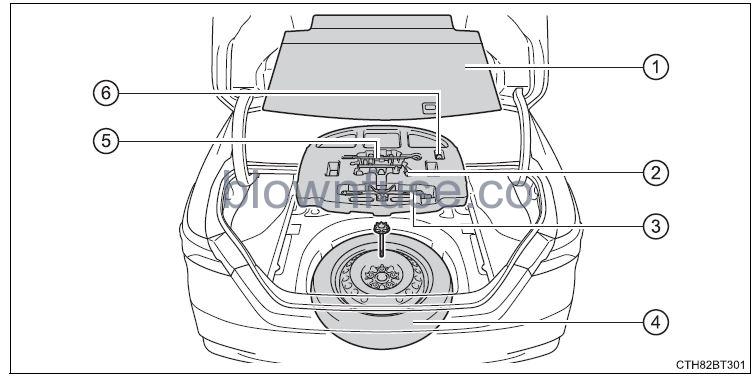
AWD models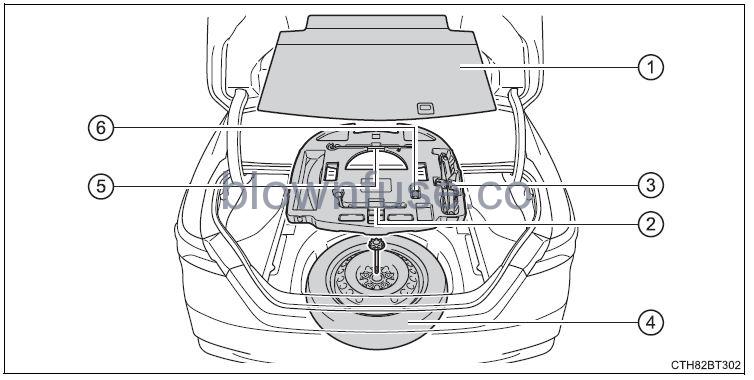
- Luggage floor cover
- Wheel nut wrench
- Jack
- Spare tire
- Jack handle
- Wheel lock key (if equipped)
WARNING
- Using the tire jack Observe the following precautions. Improper use of the tire jack may cause the vehicle to suddenly fall off the jack, leading to death or serious injury.
- Do not use the tire jack for any purpose other than replacing tires or installing and removing tire chains.
- Only use the tire jack that comes with this vehicle for replacing a flat tire.
- Do not use it on other vehicles, and do not use other tire jacks for replacing tires on this vehicle.
- Put the jack properly in its jack point.
- Do not put any part of your body under the vehicle while it is supported by the jack.
- Do not start the engine or drive the vehicle while the vehicle is supported by the jack.
- Do not raise the vehicle while someone is inside.
- When raising the vehicle, do not put an object on or under the jack.
- Do not raise the vehicle to a height greater than that required to replace the tire.
- Use a jack stand if it is necessary to get under the vehicle.
- When lowering the vehicle, make sure that there is no one near the vehicle. If there are people nearby, warn them vocally before lowering.
NOTICE
To prevent damage to the vehicle when using a jack When jacking up the rear of the vehicle, make sure not to position the jack under the bracket shown in the illustration near the rear jack point, as the vehicle body may be damaged.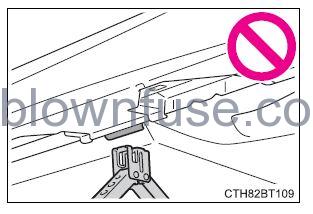
Wheel lock nut (if equipped)
When replacing tires on a vehicle with wheel lock nuts, use the following procedures to remove and install the wheel lock nuts. The wheel lock key is stored in the tray inside the luggage compartment. Always return the wheel lock key to its original position after use, so that it does not get lost. (P. 544)
- Removal: For ease of removal, the wheel lock nut should always be the first one loosened.
- Place the wheel lock key on top of the wheel lock nut, turning until the wheel lock key and wheel lock nut patterns engage.
- Place the wheel nut wrench on the wheel lock key, and while applying pressure on the wheel lock key, loosen the wheel lock nut.
- Installation: For ease of installation, the wheel lock nut should always be the last one tightened.
- By hand, install a wheel lock nut on the wheel to be installed.
- Place the wheel lock key on top of the wheel lock nut, turning until the wheel lock key and wheel lock nut patterns engage.
- Place the wheel nut wrench on the wheel lock key, and while applying pressure on the wheel lock key, tighten the wheel lock nut to the recommended torque.
NOTICE
When using a wheel lock key Do not use an impact wrench. Using an impact wrench may cause permanent damage to the wheel lock nut and wheel lock key. If in doubt about the wheel lock application, contact your Toyota dealer.
Taking out the jack
- Lift up the hook of the luggage floor cover on the trunk floor.
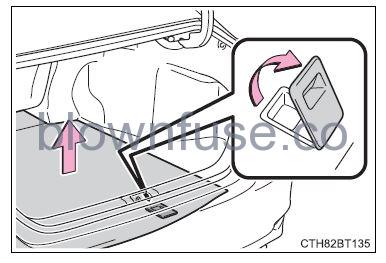
- Secure the luggage floor cover using the hook provided.

- Remove the jack.
- 2WD models
- AWD models

Taking out the spare tire
- Lift up the hook of the luggage floor cover on the trunk floor.
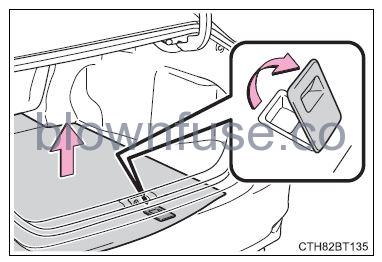
- Secure the luggage floor cover using the hook provided.
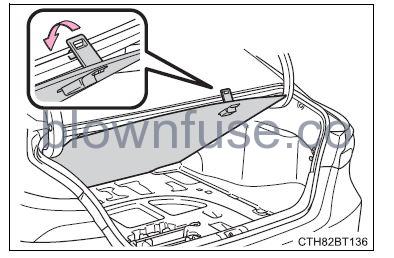
- Remove the tool tray.
- Loosen the center fastener that secures the spare tire. When taking out or stowing the spare tire, make sure to firmly hold the opposite end of the tire.
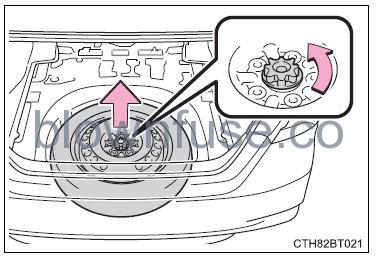
- 2WD models
- AWD models
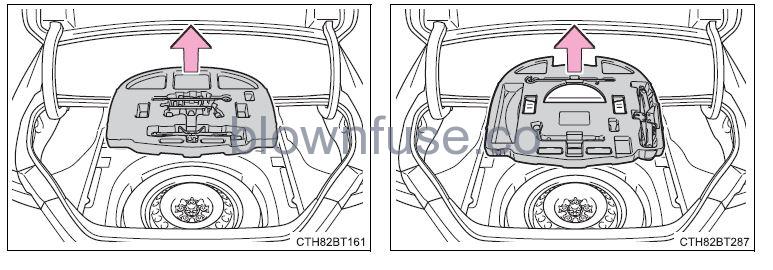
WARNING
When storing the spare tire Be careful not to catch fingers or other body parts between the spare tire and the body of the vehicle.
Replacing a flat tire
- Check the tires.

Flat tire Wheel chock positions Front
Left-hand side Behind the rear right-hand side tire Right-hand side Behind the rear left-hand side tire Rear
Left-hand side In front of the front right-hand side tire Right-hand side In front of the front left-hand side tire - For vehicles with steel wheels, remove the wheel ornament using the wrench.
- To protect the wheel ornament, place a rag between the wrench and the wheel ornament, as shown in the illustration.
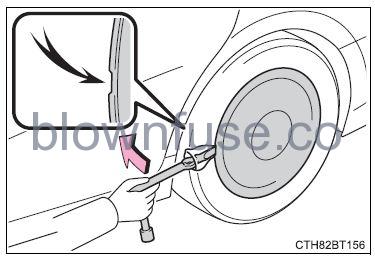
- To protect the wheel ornament, place a rag between the wrench and the wheel ornament, as shown in the illustration.
- Slightly loosen the wheel nuts (one turn). Vehicles with wheel locks: Use the wheel lock key to loosen the wheel lock.
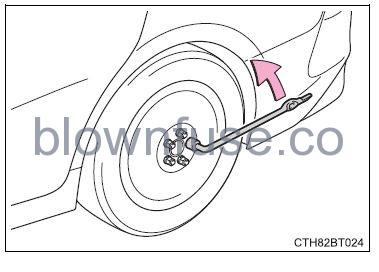
- Turn the tire jack portion “A” by hand until the notch of the jack is in contact with the jack point.
- To prevent damage to the vehicle when using the jack, position the jack in the correct location.
- The jack point guides are located under the rocker panel. They indicate the jack point positions.
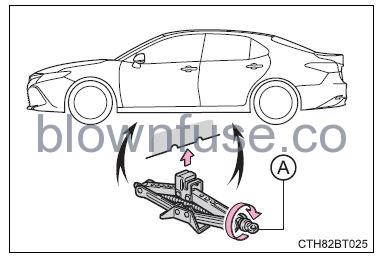
- Assemble the jack handle.
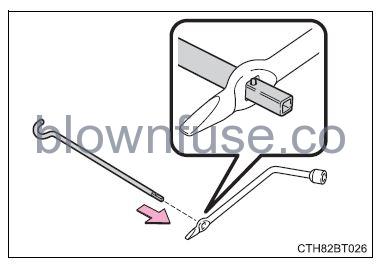
- Raise the vehicle until the tire is slightly raised off the ground.
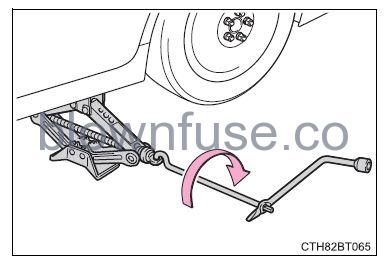
- Remove all the wheel nuts and the tire.
- When resting the tire on the ground, place the tire so that the wheel design faces up to avoid scratching the wheel surface.
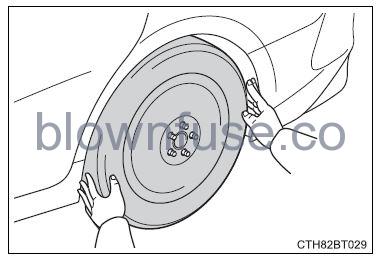
- When resting the tire on the ground, place the tire so that the wheel design faces up to avoid scratching the wheel surface.
WARNING
- Replacing a flat tire
- Do not touch the disc wheels or the area around the brakes immediately after the vehicle has been driven.
- After the vehicle has been driven the disc wheels and the area around the brakes will be extremely hot. Touching these areas with hands, feet, or other body parts while changing a tire, etc. may result in burns.
- Failure to follow these precautions could cause the wheel nuts to loosen and the tire to fall off, resulting in death or serious injury.
- Have the wheel nuts tightened with a torque wrench to 76 ft•lbf (103 N•m, 10.5 kgf•m) as soon as possible after changing wheels?
- Do not attach a heavily damaged wheel ornament, as it may fly off the wheel while the vehicle is moving.
- When installing a tire, only use wheel nuts that have been specifically designed for that wheel.
- If there are any cracks or deformations in the bolt screws, nut threads, or bolt holes of the wheel, have the vehicle inspected by your Toyota dealer.
- When installing the wheel nuts, be sure to install them with the tapered ends facing inward.
- Do not touch the disc wheels or the area around the brakes immediately after the vehicle has been driven.
Installing the spare tire
- Remove any dirt or foreign matter from the wheel contact surface.
- If foreign matter is on the wheel contact surface, the wheel nuts may loosen while the vehicle is in motion, causing the tire to come off.
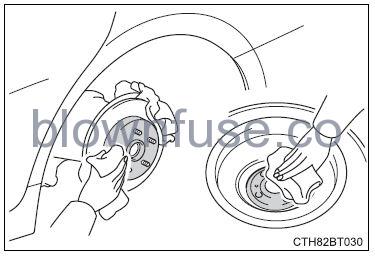
- If foreign matter is on the wheel contact surface, the wheel nuts may loosen while the vehicle is in motion, causing the tire to come off.
- Install the tire and loosely tighten each wheel nut by hand by approximately the same amount.
- When replacing a steel wheel with a steel wheel, tighten the wheel nuts until the tapered portion comes into loose contact with the disc wheel seat.

- When replacing an aluminum wheel with a steel wheel, tighten the wheel nuts until the tapered portion comes into loose contact with the disc wheel seat.

- When replacing a steel wheel with a steel wheel, tighten the wheel nuts until the tapered portion comes into loose contact with the disc wheel seat.
- Lower the vehicle.
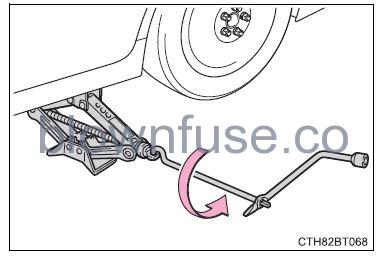
- Firmly tighten each wheel nut two or three times in the order shown in the illustration. Vehicles with wheel locks: Tighten the wheel lock using the wheel lock key after tightening the other wheel nuts. Tightening torque: 76 ft•lbf (103 N•m, 10.5 kgf•m)
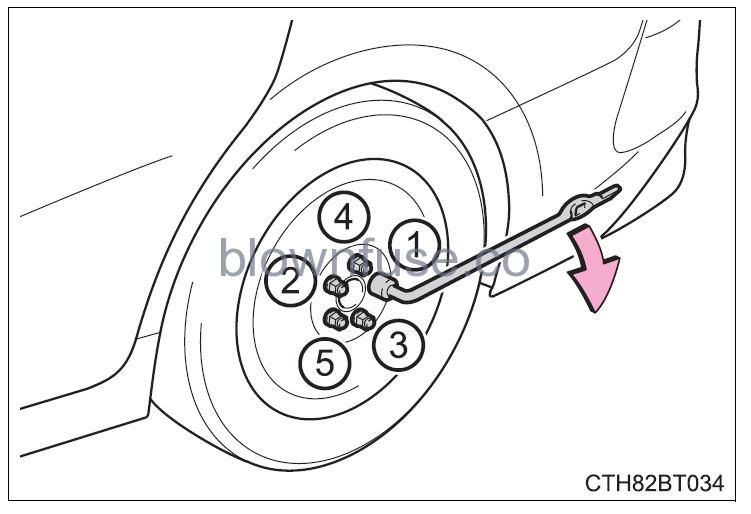
- Stow the flat tire, tire jack, and all tools.
- The compact spare tire
- The compact spare tire is identified by the label “TEMPORARY USE ONLY” on the tire sidewall.
- Use the compact spare tire temporarily, and only in an emergency.
- Make sure to check the tire inflation pressure of the compact spare tire. ( P. 584)
- The compact spare tire is identified by the label “TEMPORARY USE ONLY” on the tire sidewall.
- When using the compact spare tire
- As the compact spare tire is not equipped with a tire pressure warning valve and transmitter, the low inflation pressure of the spare tire will not be indicated by the tire pressure warning system. Also, if you replace the compact spare tire after the tire pressure warning light comes on, the light remains on.
- When the compact spare tire is equipped
- When driving with the compact spare tire installed, the vehicle height will be different than when driving with standard tires.
- If you have a flat front tire on a road covered with snow or ice (vehicles with 16 or 17-inch wheels)
- Install the compact spare tire on one of the rear wheels of the vehicle. Perform the following steps and fit tire chains to the front tires:
- Replace a rear tire with a compact spare tire.
- Replace the flat front tire with the tire removed from the rear of the vehicle.
- Fit tire chains to the front tires.
- Install the compact spare tire on one of the rear wheels of the vehicle. Perform the following steps and fit tire chains to the front tires:
WARNING
- When using the compact spare tire
- Remember that the compact spare tire provided is specifically designed for use with your vehicle. Do not use your compact spare tire on another vehicle.
- Do not use more than one compact spare tire simultaneously.
- Replace the compact spare tire with a standard tire as soon as possible.
- Avoid sudden acceleration, abrupt steering, sudden braking, and shifting operations that cause sudden engine braking.
When the compact spare tire is attached
The vehicle speed may not be correctly detected, and the following systems may not operate correctly
- ABS & Brake assist
- VSC
- TRAC
- EPS
- AHB (Automatic High Beam)
- Dynamic radar cruise control
- Dynamic radar cruise control with full-speed range
- LTA (Lane Tracing Assist)
- PCS (Pre-Collision System)
- Tire pressure warning system
- BSM (Blind Spot Monitor)
- Intuitive parking assist*
- PKSB (Parking Support Brake)
- Rearview monitor system
- Toyota parking assist monitor
- Panoramic view monitor
- Navigation system
Also, not only can the following systems not be utilized fully, but they may actually negatively affect the drive-train components:
- Dynamic Torque-Control AWD system*
- If equipped
Speed limit when using the compact spare tire
- Do not drive at speeds in excess of 50 mph (80 km/h) when a compact spare tire is installed on the vehicle.
- The compact spare tire is not designed for driving at high speeds. Failure to observe this precaution may lead to an accident causing death or serious injury.
After using the tools and jack
Before driving, make sure all the tools and jacks are securely in place in their storage location to reduce the possibility of personal injury during a collision or sudden braking.
NOTICE
- Be careful when driving over bumps with the compact spare tire installed on the vehicle.
- The vehicle becomes lower when driving with the compact spare tire compared to when driving with standard tires. Be careful when driving over uneven road surfaces.
- Driving with tire chains and the compact spare tire
- Do not fit tire chains to the compact spare tire.
Tire chains may damage the vehicle’s body and adversely affect driving performance.
- Do not fit tire chains to the compact spare tire.
- When replacing the tires
- When removing or fitting the wheels, tires, or the tire pressure warning valve and transmitter, contact your Toyota dealer as the tire pressure warning valve and transmitter may be damaged if not handled correctly.
- To avoid damage to the tire pressure warning valve and transmitters
- When a tire is repaired with liquid sealants, the tire pressure warning valve and transmitter may not operate properly. If a liquid sealant is used, contact your Toyota dealer or another qualified service shop as soon as possible. Make sure to replace the tire pressure warning valve and transmitter when replacing the tire. (P. 475)
If the engine will not start
If the engine will not start even though correct starting procedures are being followed (P. 209, 211), consider each of the following points:
The engine will not start even though the starter motor operates normally.
One of the following may be the cause of the problem:
- There may not be sufficient fuel in the vehicle’s tank.
- Refuel the vehicle.
- The engine may be flooded.
- Try to restart the engine again following the correct starting procedures. ( P. 209, 211)
- There may be a malfunction in the engine immobilizer system. ( P. 80)
The starter motor turns over slowly, the interior lights and headlights are dim, or the horn does not sound or sounds at a low volume.
One of the following may be the cause of the problem
- The battery may be discharged. (P. 562)
- The battery terminal connections may be loose or corroded.
The starter motor does not turn over (vehicles with a smart key system)
The engine starting system may be malfunctioning due to an electrical problem such as electronic key battery depletion or a blown fuse. However, an interim measure is available to start the engine. (P. 558)
The starter motor does not turn over, the interior lights and headlights do not turn on, or the horn does not sound.
One of the following may be the cause of the problem
- One or both of the battery terminals may be disconnected.
- The battery may be discharged. (P. 562)
- There may be a malfunction in the steering lock system (vehicles with a smart key system).
- Contact your Toyota dealer if the problem cannot be repaired, or if repair procedures are unknown.
Emergency start function (vehicles with a smart key system)
When the engine does not start, the following steps can be used as an interim measure to start the engine if the engine switch is functioning normally:
- Set the parking brake.
- Shift the shift lever to P.
- Turn the engine switch to ACCESSORY mode.
- Press and hold the engine switch for about 15 seconds while depressing the brake pedal firmly.
Even if the engine can be started using the above steps, the system may malfunction. Has the vehicle been inspected by your Toyota dealer?
If the electronic key does not operate properly (vehicles with a smart key system)
If communication between the electronic key and vehicle is interrupted (P. 163) or the electronic key cannot be used because the battery is depleted, the smart key system and wireless remote control cannot be used. In such cases, the doors and trunk can be opened and the engine can be started by following the procedure below.
Locking and unlocking the doors, unlocking the trunk, and key linked functions
Doors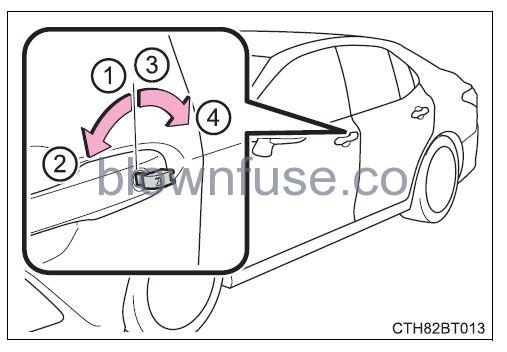
Using the mechanical key (P.142) in order to perform the following operations (driver’s door only):
- Locks all doors
- Closes the windows and the moon roof*1 or panoramic moon roof*1 (turn and hold)*2
- Unlocks the door
- Turning the key rearward unlocks the driver’s door. Turning the key once again unlocks the other doors.
- Opens the windows and the moon roof*1 or panoramic moon roof*1 (turn and hold)*2
- If equipped
- This setting must be customized at your Toyota dealer.
Trunk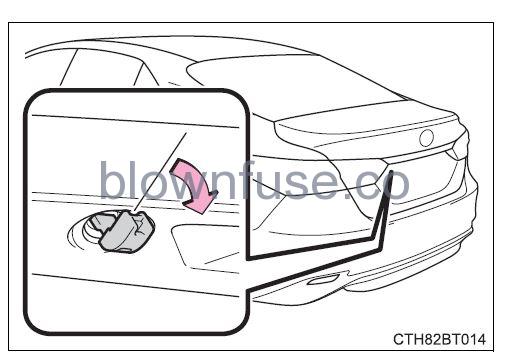
Turn the mechanical key clockwise to open.
Starting the engine
- Ensure that the shift lever is in P and firmly depress the brake pedal.
- Touch the Toyota emblem side of the electronic key to the engine switch.
- When the electronic key is detected, a buzzer sounds, and the engine switch will turn to IGNITION ON mode.
- When the smart key system is deactivated in the customization setting, the engine switch will turn to ACCESSORY mode.
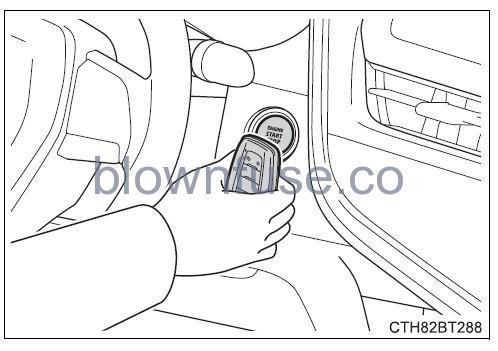
- Firmly depress the brake pedal and check that
 is displayed on the multi-information display.
is displayed on the multi-information display. - Press the engine switch shortly and firmly.
Stopping the engine
Shift the shift lever to P and press the engine switch as you normally do when stopping the engine.
Replacing the key battery
As the above procedure is a temporary measure, it is recommended that the electronic key battery be replaced immediately when the battery is depleted. ( P. 494)
Alarm (for Canada only)
Using the mechanical key to lock the doors will not set the alarm system. If a door is unlocked using the mechanical key when the alarm system is set, the alarm may be triggered.
Changing engine switch modes
Release the brake pedal and press the engine switch in step 3 above. The engine does not start and modes will be changed each time the switch is pressed. (P. 213)
When the electronic key does not work properly
- Make sure that the smart key system has not been deactivated in the customization setting. If it is off, turn the function on. (Customizable features: P. 606)
- Check if the battery-saving mode is set. If it is set, cancel the function. ( P. 163)
WARNING
When using the mechanical key and operating the power windows or the moon roof or panoramic moon roof Operate the power window or the moon roof or panoramic moon roof after checking to make sure that there is no possibility of any passenger having any of their body parts caught in the window or the moon roof or panoramic moon roof. Also, do not allow children to operate the mechanical key. It is possible for children and other passengers to get caught in the power window or the moon roof or panoramic moon roof.
If the vehicle battery is discharged
The following procedures may be used to start the engine if the vehicle’s battery is discharged. You can also call your Toyota dealer or a qualified repair shop.
If you have a set of jumper (or booster) cables and a second vehicle with a 12-volt battery, you can jump-start your vehicle by following the steps below.
- Confirm that the electronic key (vehicles with a smart key system) or key (vehicles without a smart key system) is being carried.
- When connecting the jumper (or booster) cables, depending on the situation, the alarm may activate and doors locked. (P. 84)

- When connecting the jumper (or booster) cables, depending on the situation, the alarm may activate and doors locked. (P. 84)
- Open the hood. (P. 457)
- Vehicles with 3.5 L V6 (2GR-FKS) engine: Remove the engine cover.
- Make sure to pull the engine cover straight up when removing it.
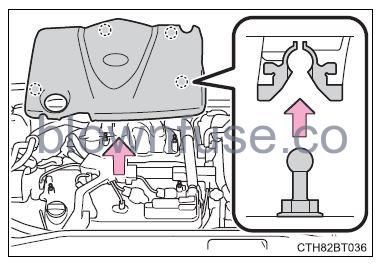
- Make sure to pull the engine cover straight up when removing it.
- Connect the jumper cables according to the following procedure:
2.5 L 4-cylinder (A25A-FKS) engine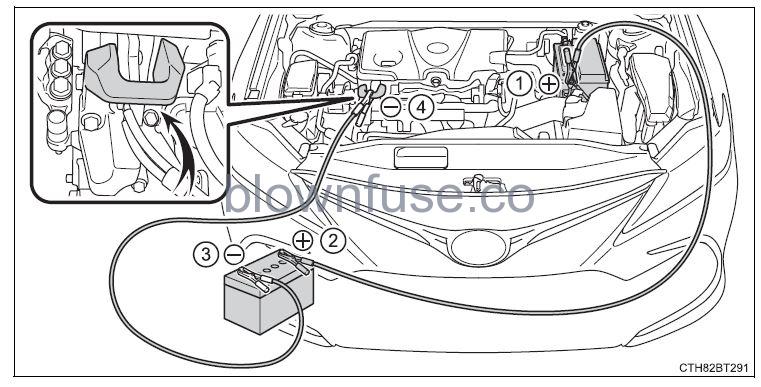
3.5 L V6 (2GR-FKS) engine
- Connect a positive jumper cable clamp to the positive (+) battery terminal on your vehicle.
- Connect the clamp on the other end of the positive cable to the positive (+) battery terminal on the second vehicle.
- Connect a negative cable clamp to the negative (-) battery terminal on the second vehicle.
- Connect the clamp at the other end of the negative cable to a solid, stationary, unpainted metallic point away from the battery and any moving parts, as shown in the illustration.
- Start the engine of the second vehicle. Increase the engine speed slightly and maintain it at that level for approximately 5 minutes to recharge the battery of your vehicle.
- Vehicles with a smart key system: Open and close any of the doors of your vehicle with the engine switch off.
- Vehicles without a smart key system:
- Maintain the engine speed of the second vehicle and turn the engine switch to the “ON” position, then start the vehicle’s engine.
- Vehicles with a smart key system:
- Maintain the engine speed of the second vehicle and turn the engine switch to IGNITION ON mode, then start the vehicle’s engine.
- Once the vehicle’s engine has started, remove the jumper cables in the exact reverse order from which they were connected.
Once the engine starts have the vehicle inspected at your Toyota dealer as soon as possible.
Starting the engine when the battery is discharged
The engine cannot be started by push-starting.
To prevent battery discharge
● Turn off the headlights and the audio system while the engine is off.
● Turn off any unnecessary electrical components when the vehicle is running at a low speed for an extended period, such as in heavy traffic.
When the battery is removed or discharged
● Information stored in the ECU is cleared. When the battery is depleted, have the vehicle inspected at your Toyota dealer.
● Some systems may require initialization. (→P. 614)
When removing the battery terminals
When the battery terminals are removed, the information stored in the ECU is cleared. Before removing the battery terminals, contact your Toyota dealer.
Charging the battery
The electricity stored in the battery will discharge gradually even when the vehicle is not in use, due to natural discharge and the draining effects of certain electrical appliances. If the vehicle is left for a long time, the battery may discharge, and the engine may be unable to start. (The battery recharges automatically during driving.)
When recharging or replacing the battery (vehicles with a smart key system)
- In some cases, it may not be possible to unlock the doors using the smart key system when the battery is discharged. Use the wireless remote control or the mechanical key to lock or unlock the doors.
- The engine may not start on the first attempt after the battery has recharged but will start normally after the second attempt. This is not a malfunction.
- The engine switch mode is memorized by the vehicle. When the battery is reconnected, the system will return to the mode it was in before the battery was discharged. Before disconnecting the battery, turn the engine switch off. If you are unsure what mode the engine switch was in before the battery discharged, be especially careful when reconnecting the battery.
When replacing the battery
- Use a battery that conforms to European regulations.
- Use a battery with the same case size, equivalent or greater 20-hour rate capacity (20HR), and equivalent or greater performance rating (CCA) as the battery which is being replaced.
The case size, 20-hour rate capacity (20HR), and performance rating (CCA) are specified on the label attached to the battery.
- If the sizes differ, the battery cannot be properly secured.
- If the 20-hour rate capacity is low, even if the time period where the vehicle is not used is a short time, the battery may discharge and the engine may not be able to start.
For details, consult your Toyota dealer.
WARNING
- When removing the battery terminals
- Always remove the negative (-) terminal first. If the positive (+) terminal contacts any metal in the surrounding area when the positive (+) terminal is removed, a spark may occur, leading to a fire in addition to electrical shocks and death or serious injury.
- Avoiding battery fires or explosions
Observe the following precautions to prevent accidentally igniting the flammable gas that may be emitted from the battery:- Make sure each jumper cable is connected to the correct terminal and that it is not unintentionally in contact with any other than the intended terminal.
- Do not allow the other end of the jumper cable connected to the “+” terminal to come into contact with any other parts or metal surfaces in the area, such as brackets or unpainted metal.
- Do not allow the + and – clamps of the jumper cables to come into contact with each other.
- Do not smoke, use matches, cigarette lighters, or allow open flame near the battery.
- Battery precautions
The battery contains poisonous and corrosive acidic electrolytes, while related parts contain lead and lead compounds. Observe the following precautions when handling the battery:- When working with the battery, always wear safety glasses and take care not to allow any battery fluids (acid) to come into contact with skin, clothing, or the vehicle body.
- Do not lean over the battery.
- In the event that battery fluid comes into contact with the skin or eyes, immediately wash the affected area with water and seek medical attention. Place a wet sponge or cloth over the affected area until medical attention can be received.
- Always wash your hands after handling the battery support, terminals, and other battery-related parts.
- Do not allow children near the battery.
NOTICE
When handling jumper cables When connecting the jumper cables, ensure that they do not become entangled in the cooling fan or engine drive belt.
If your vehicle overheats
The following may indicate that your vehicle is overheating.
- The needle of the engine coolant temperature gauge (P. 94) enters the red zone or a loss of engine power is experienced. (For example, the vehicle speed does not increase.)
- “Engine Coolant Temp High Stop in a Safe Place See Owner’s Manual” is shown on the multi-information display.
- Steam comes out from under the hood.
Correction procedures
- Stop the vehicle in a safe place and turn off the air conditioning system, and then stop the engine.
- If you see steam: Carefully lift the hood after the steam subsides.
- If you do not see steam: Carefully lift the hood.
- After the engine has cooled down sufficiently, inspect the hoses and radiator core (radiator) for any leaks.

- Radiator
- Cooling fan
- If a large number of coolant leaks, immediately contact your Toyota dealer.
- The coolant level is satisfactory if it is between the “F” and “L” lines on the reservoir.
- Reservoir
- “F” line
- “L” line
- Radiator cap
- 2.5 L 4-cylinder (A25A-FKS) engine
- 3.5 L V6 (2GR-FKS) engine

Add coolant if necessary. Water can be used in an emergency if coolant is unavailable
- 2.5 L 4-cylinder (A25A-FKS) engine
- 3.5 L V6 (2GR-FKS) engine

- Start the engine and turn the air conditioning system on to check that the radiator cooling fan operates and to check for coolant leaks from the radiator or hoses.
- The fan operates when the air conditioning system is turned on immediately after a cold start. Confirm that the fan is operating by checking the fan sound and airflow. If it is difficult to check these, turn the air conditioning system on and off repeatedly. (The fan may not operate in freezing temperatures.)
- If the fan is not operating:
- Stop the engine immediately and contact your Toyota dealer.
- If the fan is operating:
- Has the vehicle been inspected at the nearest Toyota dealer?
WARNING
- To prevent an accident or injury when inspecting under the hood of your vehicle Observe the following precautions.
Failure to do so may result in serious injury such as burns.- If steam is seen coming from under the hood, do not open the hood until the steam has subsided. The engine compartment may be very hot.
- Keep hands and clothing (especially a tie, a scarf, or a muffler) away from the fan and belts. Failure to do so may cause the hands or clothing to be caught, resulting in serious injury.
- Do not loosen the radiator cap and the coolant reservoir cap while the engine and radiator are hot.
- High-temperature steam or coolant could spray out..
NOTICE
- When adding engine coolant
- Wait until the engine has cooled down before adding engine coolant. When adding coolant, do so slowly. Adding cool coolant to a hot engine too quickly can cause damage to the engine.
- To prevent damage to the cooling system
- Observe the following precautions:
- Avoid contaminating the coolant with foreign matter (such as sand or dust etc.).
- Do not use any coolant additives.
- Observe the following precautions:
If the vehicle becomes stuck
Carry out the following procedures if the tires spin or the vehicle becomes stuck in mud, dirt or snow:
- Stop the engine. Set the parking brake and shift the shift lever to P.
- Remove the mud, snow or sand from around the front wheels. Place wood, stones or some other material under the front wheels to help
- provide traction.
- Restart the engine.
- Shift the shift lever to D or R and release the parking brake. Then, while exercising caution, depress the accelerator pedal.
When it is difficult to free the vehicle Press  to turn off TRAC.
to turn off TRAC.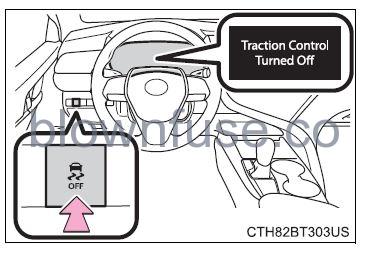
WARNING
- When attempting to free a stuck vehicle
- If you choose to push the vehicle back and forth to free it, make sure the surrounding area is clear to avoid striking other vehicles, objects or people. The vehicle may also lunge forward or lunge back suddenly as it becomes free. Use extreme caution.
- When shifting the shift lever
- Be careful not to shift the shift lever with the accelerator pedal depressed. This may lead to unexpected rapid acceleration of the vehicle that may cause an accident resulting in death or serious injury.
NOTICE
- To avoid damaging the transmission and other components
- Avoid spinning the front wheels and depressing the accelerator pedal more than necessary.
- If the vehicle remains stuck even after these procedures are performed, the vehicle may require towing to be freed.


